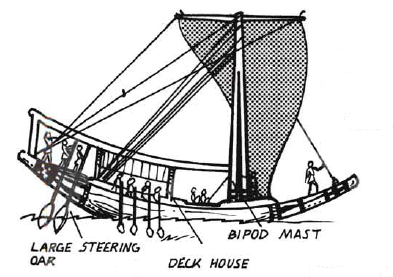Egyptian Boat
Era
Egyptian (c. 1450 BCE).
Background
The Nile dominated Egyptian society. All major settlements lay on the Nile, and therefore river boats were the main method of travel throughout the kingdom. Boats came in all shapes and sizes, and construction style changed over the centuries.
In Egypt, a strong northerly wind blew constantly through the daylight hours, with sufficient force to propel boats up the Nile against the flow of the current. To travel down river, the sail would be lowered and the boat would be steered with the current. In this way, fairly large vessels could be managed with small crews. However, oarsmen could be employed to drive the boat faster or to navigate those brief stretches where a bend in the river caused both wind and current to be against the boat. Such a situation existed between the third and fourth cataracts, where the river made a great s-shaped bend so that for a long stretch it was flowing south.
Nekure's Boat
When Nekure, the administrator of Hebenu, sent an expedition south down the Nile to the temple of Nut at the fourth cataract, he furnished them with a small boat of an old design, as illustrated here.

It was a small craft and in such a poor state that it should have been retired years ago. It was large enough to carry the six-person expedition and their trade goods comfortably, and small enough that it could be handled by one competent sailor, and could take a crew of eight additional oarsmen if required. There was no below-deck space, but a covered deck house provided shelter from the sun. At night, the crew would anchor the boat and make camp on the shore as there was little space for comfortable sleeping or the preparation of food on the boat.